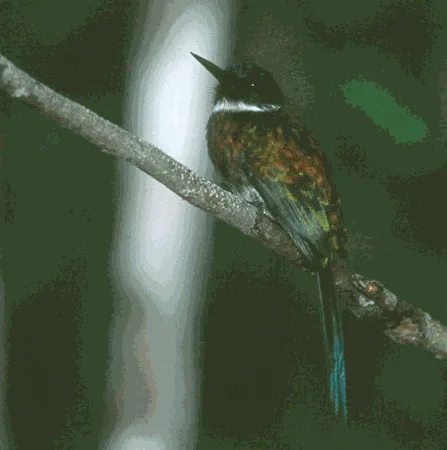
Bronzy Jacamar
[order] PICIFORMES | [family] Galbulidae | [latin] Galbula leucogastra | [UK] Bronzy Jacamar | [FR] Jacamar a ventre blanc | [DE] Bronze-Glanzvogel | [ES] Jacamara Violaceo | [NL] Bronskleurige Glansvogel
Subspecies
| Genus | Species | subspecies | Breeding Range | Breeding Range 2 | Non Breeding Range |
| Galbula | leucogastra | SA | c Amazonia | ||
| Galbula | leucogastra | leucogastra | s Venezuela, the Guianas, w Brazil and n Bolivia | ||
| Galbula | leucogastra | viridissima | c Brazil |
Physical charateristics
Its upperparts and breast are a beautiful bronzy metallic green and the crown is dark blue. The male has a white throat and belly while the female has a buff throat and belly.
Listen to the sound of Bronzy Jacamar
[audio:http://www.aviflevoland.nl/sounddb/B/Bronzy Jacamar.mp3]
Copyright remark: Most sounds derived from xeno-canto
| wingspan min.: | 0 | cm | wingspan max.: | 0 | cm |
| size min.: | 19 | cm | size max.: | 22 | cm |
| incubation min.: | 0 | days | incubation max.: | 0 | days |
| fledging min.: | 0 | days | fledging max.: | 0 | days |
| broods: | 0 | eggs min.: | 0 | ||
| eggs max.: | 0 |
Range
South America : Central Amazonia
Habitat
Its natural habitats are subtropical or tropical moist lowland forests and subtropical or tropical dry shrubland.
Reproduction
Only two nests known, both in arboreal termitaria. No further data.
Feeding habits
Perches and sallies from open branches 2-10 meter up, mostly single but also in pairs or small groups. Feeds on insects.
Conservation
This species has an extremely large range, and hence does not approach the thresholds for Vulnerable under the range size criterion (Extent of Occurrence <20,000 km2 combined with a declining or fluctuating range size, habitat extent/quality, or population size and a small number of locations or severe fragmentation). Despite the fact that the population trend appears to be decreasing, the decline is not believed to be sufficiently rapid to approach the thresholds for Vulnerable under the population trend criterion (>30% decline over ten years or three generations). The population size has not been quantified, but it is not believed to approach the thresholds for Vulnerable under the population size criterion (<10,000 mature individuals with a continuing decline estimated to be >10% in ten years or three generations, or with a specified population structure). For these reasons the species is evaluated as Least Concern.
It is found in Bolivia, Brazil, Colombia, French Guiana, Guyana, Suriname, and Venezuela. IN Suriname not uncommon along the edges of Savannah forest.

Migration
Sedentary throughout range.
Distribution map

